window Abarth Grande Punto 2010 Owner handbook (in English)
[x] Cancel search | Manufacturer: ABARTH, Model Year: 2010, Model line: Grande Punto, Model: Abarth Grande Punto 2010Pages: 207, PDF Size: 3.01 MB
Page 69 of 207

67
SAFETY
DEVICES
CORRECT USE
OF THE CAR
WARNING
LIGHTS AND
MESSAGES
IIN AN
EMERGENCY
CAR
MAINTENANCE
TECHNICAL
SPECIFICATIONS
INDEX
DASHBOARD
AND CONTROLS
fig. 74F0M018Ab
Front and rear passenger door
windows (for versions/markets,
where provided)
Front passenger door armrest and rear
door armrests feature the switches A-
fig. 74to be used for controlling the cor-
responding window.
Improper use of the power
windows can be dangerous.
Before and during its operation en-
sure that any passengers are not at
risk from the moving glass either by
personal objects getting caught in the
mechanism or by being injured by it
directly. Always remove the ignition
key when getting out of the car to
prevent the power windows being op-
erated accidentally and constituting
a danger to the passengers in the car.
WARNINGWindow safety system initialisation
Safety system shall be re-initialised after
disconnecting the battery or if the rele-
vant protection fuse is blown.
Initialisation procedure:
❒fully close manually the window to ini-
tialise;
❒after window stopping, keep on press-
ing the closing control for at least 1 sec-
ond.
Page 75 of 207
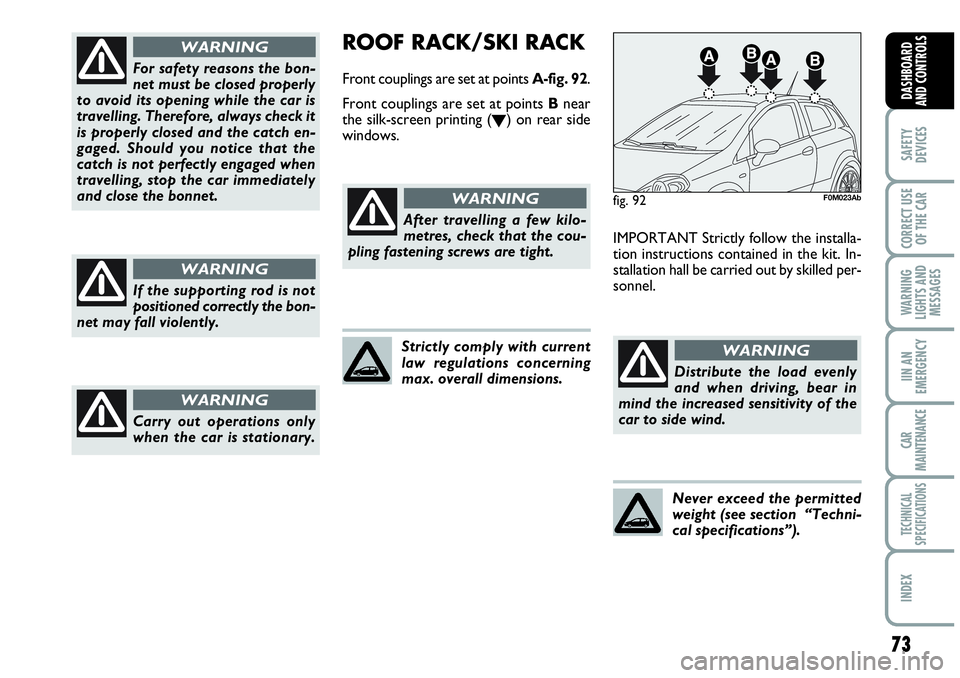
73
SAFETY
DEVICES
CORRECT USE
OF THE CAR
WARNING
LIGHTS AND
MESSAGES
IIN AN
EMERGENCY
CAR
MAINTENANCE
TECHNICAL
SPECIFICATIONS
INDEX
DASHBOARD
AND CONTROLS
For safety reasons the bon-
net must be closed properly
to avoid its opening while the car is
travelling. Therefore, always check it
is properly closed and the catch en-
gaged. Should you notice that the
catch is not perfectly engaged when
travelling, stop the car immediately
and close the bonnet.
WARNING
If the supporting rod is not
positioned correctly the bon-
net may fall violently.
WARNING
Carry out operations only
when the car is stationary.
WARNING
ROOF RACK/SKI RACK
Front couplings are set at points A-fig. 92.
Front couplings are set at points Bnear
the silk-screen printing (
O) on rear side
windows.
IMPORTANT Strictly follow the installa-
tion instructions contained in the kit. In-
stallation hall be carried out by skilled per-
sonnel.
After travelling a few kilo-
metres, check that the cou-
pling fastening screws are tight.
WARNING
Strictly comply with current
law regulations concerning
max. overall dimensions.
Distribute the load evenly
and when driving, bear in
mind the increased sensitivity of the
car to side wind.
WARNING
Never exceed the permitted
weight (see section “Techni-
cal specifications”).
fig. 92F0M023Ab
Page 108 of 207

SIDE AIR BAGS
The car is fitted with front side bags for
driver and passenger (for versions/ mar-
kets, where provided) for protecting the
chest and window bags (for versions/ mar-
kets, where provided) for protecting front
and rear passengers’ head.
Side bags (for versions/markets, where
provided) protect car occupants from side
crashes of medium-high severity, by plac-
ing the cushion between the occupant and
the internal parts of the side structure of
the car.
Non-activation of side bags in other types
of collisions (front collisions, rear shunts,
roll-overs, etc...) is not a system malfunc-
tion.
In case of side crash, an electronic control
unit, when required triggers the inflation
of the cushion. The cushion immediately
inflates, placing itself as a protection, be-
tween the occupant’s body and the struc-
ture that could cause injuries. Immediate-
ly after, the cushion deflates.
Side bags (for versions/markets, where
provided) are not a replacement of but
complementary to the belts, which you
are recommended to always wear, as
specified by law in Europe and most non-
European countries.FRONT SIDE BAGS - CHEST
AND PELVIS ZONE
PROTECTION fig. 16
(for versions/markets,
where provided)
Front side bags are housed in the seat back
rests, they consist of an instant inflation
cushion designed to increase protection
of the occupants’ chest and pelvis zone in
the event of a side crash of medium-high
severity.SIDE WINDOW BAGS - HEAD
PROTECTION fig. 17
(for versions/markets,
where provided)
They consist of two “curtain” cushions,
one on the right and the other on the left
side of the car, located behind the side
coverings of the roof and covered by
proper finishing.
Window bags have been designed for pro-
tecting the head of front and rear occu-
pants in the event of side crash, thanks to
the wide cushion inflation surface.
IMPORTANT In the event of side crash,
you can obtain the best protection by the
system keeping a correct position on the
seat, allowing thus a correct window bag
unfolding.
106
CORRECT USE
OF THE CAR
WARNING
LIGHTS AND
MESSAGES
IN AN
EMERGENCY
CAR
MAINTENANCE
TECHNICAL
SPECIFICATIONS
IINDEX
DASHBOARD
AND CONTROLS
SAFETY
DEVICES
fig. 16F0M033Abfig. 17F0M0141m
Page 109 of 207
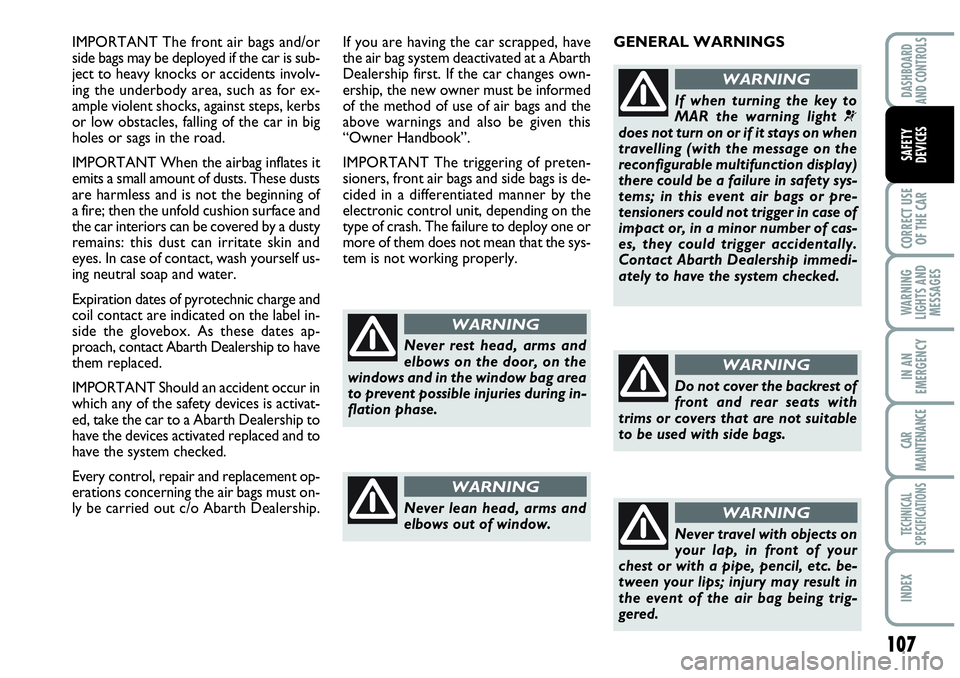
107
CORRECT USE
OF THE CAR
WARNING
LIGHTS AND
MESSAGES
IN AN
EMERGENCY
CAR
MAINTENANCE
TECHNICAL
SPECIFICATIONS
INDEX
DASHBOARD
AND CONTROLS
SAFETY
DEVICES
IMPORTANT The front air bags and/or
side bags may be deployed if the car is sub-
ject to heavy knocks or accidents involv-
ing the underbody area, such as for ex-
ample violent shocks, against steps, kerbs
or low obstacles, falling of the car in big
holes or sags in the road.
IMPORTANT When the airbag inflates it
emits a small amount of dusts. These dusts
are harmless and is not the beginning of
a fire; then the unfold cushion surface and
the car interiors can be covered by a dusty
remains: this dust can irritate skin and
eyes. In case of contact, wash yourself us-
ing neutral soap and water.
Expiration dates of pyrotechnic charge and
coil contact are indicated on the label in-
side the glovebox. As these dates ap-
proach, contact Abarth Dealership to have
them replaced.
IMPORTANT Should an accident occur in
which any of the safety devices is activat-
ed, take the car to a Abarth Dealership to
have the devices activated replaced and to
have the system checked.
Every control, repair and replacement op-
erations concerning the air bags must on-
ly be carried out c/o Abarth Dealership.If you are having the car scrapped, have
the air bag system deactivated at a Abarth
Dealership first. If the car changes own-
ership, the new owner must be informed
of the method of use of air bags and the
above warnings and also be given this
“Owner Handbook”.
IMPORTANT The triggering of preten-
sioners, front air bags and side bags is de-
cided in a differentiated manner by the
electronic control unit, depending on the
type of crash. The failure to deploy one or
more of them does not mean that the sys-
tem is not working properly.
Never rest head, arms and
elbows on the door, on the
windows and in the window bag area
to prevent possible injuries during in-
flation phase.
WARNING
Never lean head, arms and
elbows out of window.
WARNING
GENERAL WARNINGS
If when turning the key to
MAR the warning light ¬does not turn on or if it stays on when
travelling (with the message on the
reconfigurable multifunction display)
there could be a failure in safety sys-
tems; in this event air bags or pre-
tensioners could not trigger in case of
impact or, in a minor number of cas-
es, they could trigger accidentally.
Contact Abarth Dealership immedi-
ately to have the system checked.
WARNING
Do not cover the backrest of
front and rear seats with
trims or covers that are not suitable
to be used with side bags.
WARNING
Never travel with objects on
your lap, in front of your
chest or with a pipe, pencil, etc. be-
tween your lips; injury may result in
the event of the air bag being trig-
gered.
WARNING
Page 116 of 207
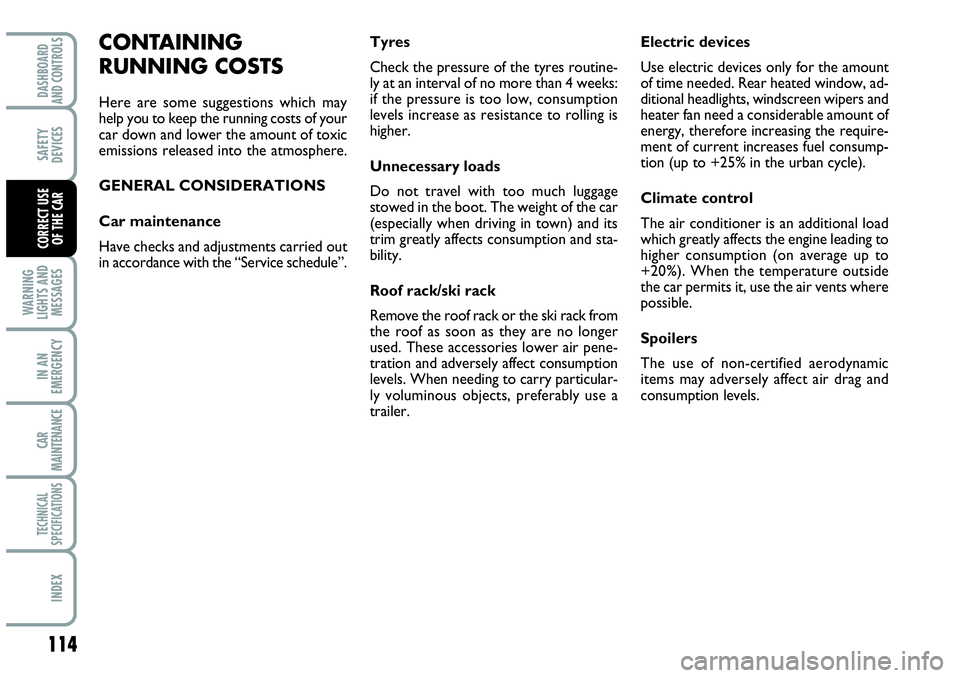
114
WARNING
LIGHTS AND
MESSAGES
IN AN
EMERGENCY
CAR
MAINTENANCE
TECHNICAL
SPECIFICATIONS
INDEX
DASHBOARD
AND CONTROLS
SAFETY
DEVICES
CORRECT USE
OF THE CAR
CONTAINING
RUNNING COSTS
Here are some suggestions which may
help you to keep the running costs of your
car down and lower the amount of toxic
emissions released into the atmosphere.
GENERAL CONSIDERATIONS
Car maintenance
Have checks and adjustments carried out
in accordance with the “Service schedule”.Tyres
Check the pressure of the tyres routine-
ly at an interval of no more than 4 weeks:
if the pressure is too low, consumption
levels increase as resistance to rolling is
higher.
Unnecessary loads
Do not travel with too much luggage
stowed in the boot. The weight of the car
(especially when driving in town) and its
trim greatly affects consumption and sta-
bility.
Roof rack/ski rack
Remove the roof rack or the ski rack from
the roof as soon as they are no longer
used. These accessories lower air pene-
tration and adversely affect consumption
levels. When needing to carry particular-
ly voluminous objects, preferably use a
trailer.Electric devices
Use electric devices only for the amount
of time needed. Rear heated window, ad-
ditional headlights, windscreen wipers and
heater fan need a considerable amount of
energy, therefore increasing the require-
ment of current increases fuel consump-
tion (up to +25% in the urban cycle).
Climate control
The air conditioner is an additional load
which greatly affects the engine leading to
higher consumption (on average up to
+20%). When the temperature outside
the car permits it, use the air vents where
possible.
Spoilers
The use of non-certified aerodynamic
items may adversely affect air drag and
consumption levels.
Page 122 of 207
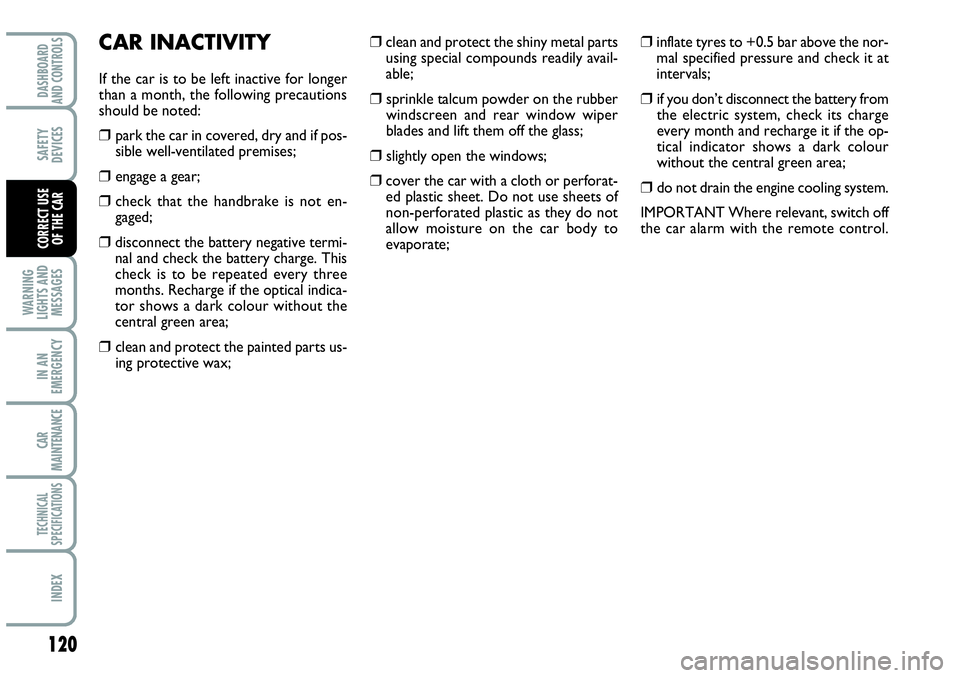
120
WARNING
LIGHTS AND
MESSAGES
IN AN
EMERGENCY
CAR
MAINTENANCE
TECHNICAL
SPECIFICATIONS
INDEX
DASHBOARD
AND CONTROLS
SAFETY
DEVICES
CORRECT USE
OF THE CAR
CAR INACTIVITY
If the car is to be left inactive for longer
than a month, the following precautions
should be noted:
❒ park the car in covered, dry and if pos-
sible well-ventilated premises;
❒ engage a gear;
❒ check that the handbrake is not en-
gaged;
❒disconnect the battery negative termi-
nal and check the battery charge. This
check is to be repeated every three
months. Recharge if the optical indica-
tor shows a dark colour without the
central green area;
❒ clean and protect the painted parts us-
ing protective wax;
❒clean and protect the shiny metal parts
using special compounds readily avail-
able;
❒ sprinkle talcum powder on the rubber
windscreen and rear window wiper
blades and lift them off the glass;
❒ slightly open the windows;
❒cover the car with a cloth or perforat-
ed plastic sheet. Do not use sheets of
non-perforated plastic as they do not
allow moisture on the car body to
evaporate;
❒inflate tyres to +0.5 bar above the nor-
mal specified pressure and check it at
intervals;
❒ if you don’t disconnect the battery from
the electric system, check its charge
every month and recharge it if the op-
tical indicator shows a dark colour
without the central green area;
❒ do not drain the engine cooling system.
IMPORTANT Where relevant, switch off
the car alarm with the remote control.
Page 154 of 207
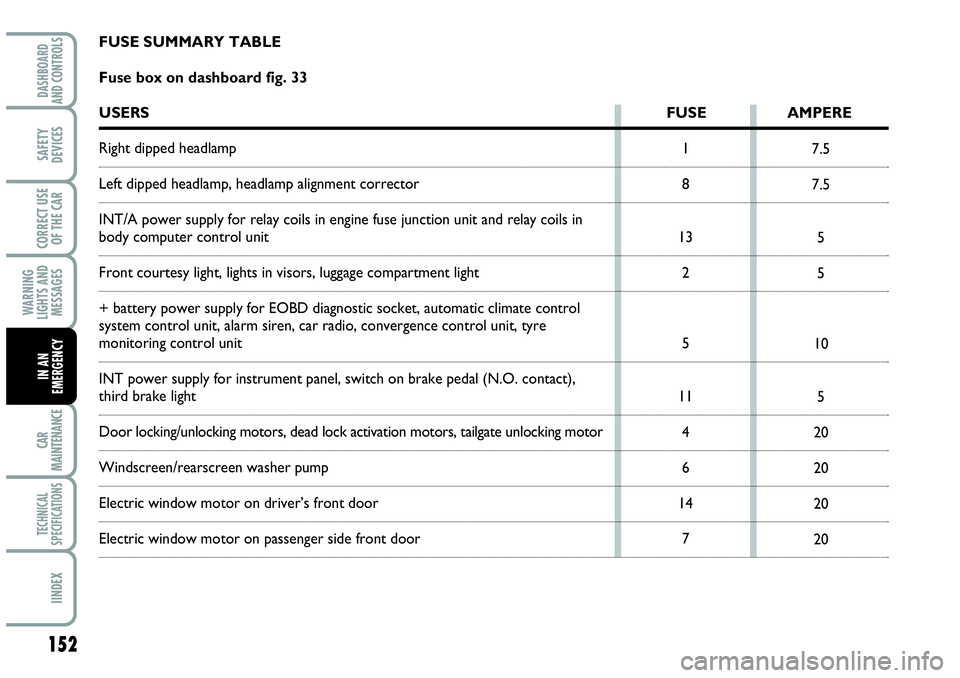
152
WARNING
LIGHTS AND
MESSAGES
CAR
MAINTENANCE
TECHNICAL
SPECIFICATIONS
IINDEX
DASHBOARD
AND CONTROLS
SAFETY
DEVICES
CORRECT USE
OF THE CAR
IN AN
EMERGENCY
7.5
7.5
5
5
10
5
20
20
20
20 1
8
13
2
5
11
4
6
14
7
FUSE SUMMARY TABLE
Fuse box on dashboard fig. 33
USERSFUSE AMPERE
Right dipped headlamp
Left dipped headlamp, headlamp alignment corrector
INT/A power supply for relay coils in engine fuse junction unit and relay coils in
body computer control unit
Front courtesy light, lights in visors, luggage compartment light
+ battery power supply for EOBD diagnostic socket, automatic climate control
system control unit, alarm siren, car radio, convergence control unit, tyre
monitoring control unit
INT power supply for instrument panel, switch on brake pedal (N.O. contact),
third brake light
Door locking/unlocking motors, dead lock activation motors, tailgate unlocking motor
Windscreen/rearscreen washer pump
Electric window motor on driver’s front door
Electric window motor on passenger side front door
Page 163 of 207

161
WARNING
LIGHTS AND
MESSAGES
TECHNICAL
SPECIFICATIONS
INDEX
DASHBOARD
AND CONTROLS
SAFETY
DEVICES
CORRECT USE
OF THE CAR
IN AN
EMERGENCY
CAR
MAINTENANCE
SCHEDULED SERVICING ................................................ 162
SERVICE SCHEDULE........................................................... 163
PERIODICAL CHECKS........................................................ 165
USE OF THE CAR UNDER HEAVY CONDITIONS ... 165
CHECKING FLUID LEVELS................................................ 166
AIR FILTER ............................................................................ 170
POLLEN FILTER ................................................................... 170
BATTERY................................................................................ 171
WHEELS AND TYRES......................................................... 173
RUBBER HOSES.................................................................... 174
WINDSCREEN/REAR WINDOW WIPERS ................... 174
BODYWORK........................................................................ 176
INTERIORS ............................................................................ 179
C C
A A
R R
M M
A A
I I
N N
T T
E E
N N
A A
N N
C C
E E
Page 167 of 207
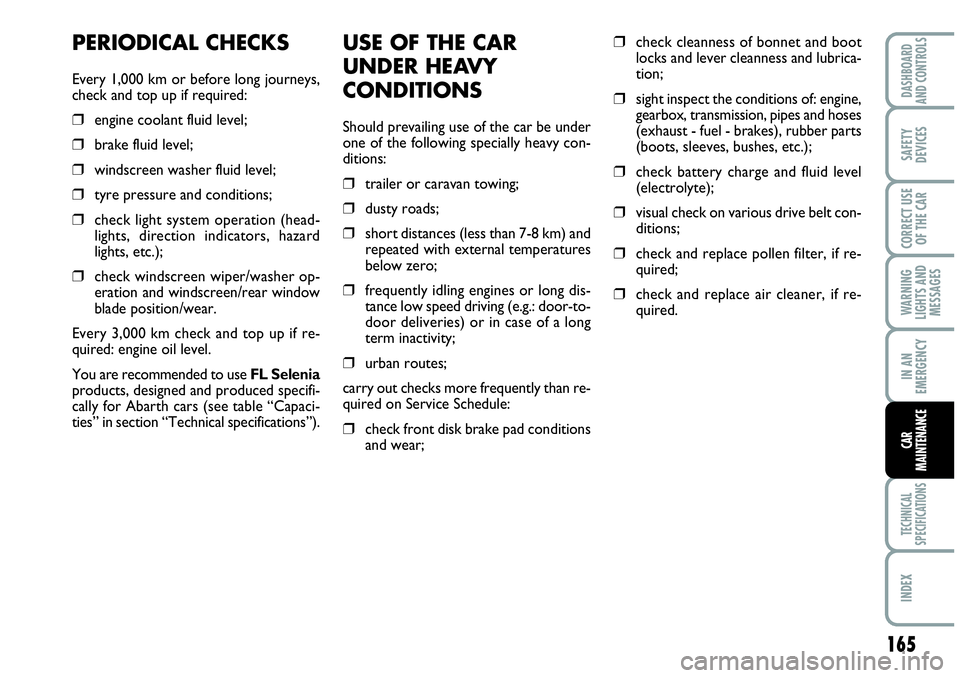
USE OF THE CAR
UNDER HEAVY
CONDITIONS
Should prevailing use of the car be under
one of the following specially heavy con-
ditions:
❒trailer or caravan towing;
❒dusty roads;
❒short distances (less than 7-8 km) and
repeated with external temperatures
below zero;
❒frequently idling engines or long dis-
tance low speed driving (e.g.: door-to-
door deliveries) or in case of a long
term inactivity;
❒urban routes;
carry out checks more frequently than re-
quired on Service Schedule:
❒check front disk brake pad conditions
and wear;
❒check cleanness of bonnet and boot
locks and lever cleanness and lubrica-
tion;
❒sight inspect the conditions of: engine,
gearbox, transmission, pipes and hoses
(exhaust - fuel - brakes), rubber parts
(boots, sleeves, bushes, etc.);
❒check battery charge and fluid level
(electrolyte);
❒visual check on various drive belt con-
ditions;
❒check and replace pollen filter, if re-
quired;
❒check and replace air cleaner, if re-
quired.
PERIODICAL CHECKS
Every 1,000 km or before long journeys,
check and top up if required:
❒engine coolant fluid level;
❒brake fluid level;
❒windscreen washer fluid level;
❒tyre pressure and conditions;
❒check light system operation (head-
lights, direction indicators, hazard
lights, etc.);
❒check windscreen wiper/washer op-
eration and windscreen/rear window
blade position/wear.
Every 3,000 km check and top up if re-
quired: engine oil level.
You are recommended to use FL Selenia
products, designed and produced specifi-
cally for Abarth cars (see table “Capaci-
ties” in section “Technical specifications”).
165
WARNING
LIGHTS AND
MESSAGES
TECHNICAL
SPECIFICATIONS
INDEX
DASHBOARD
AND CONTROLS
SAFETY
DEVICES
CORRECT USE
OF THE CAR
IN AN
EMERGENCY
CAR
MAINTENANCE
Page 170 of 207

168
WARNING
LIGHTS AND
MESSAGES
TECHNICAL
SPECIFICATIONS
INDEX
DASHBOARD
AND CONTROLS
SAFETY
DEVICES
CORRECT USE
OF THE CAR
IN AN
EMERGENCY
CAR
MAINTENANCE
WINDSCREEN/REAR WINDOW
WASHER FLUID fig. 4
To top up, remove the cap A.
Pour a mixture of water and TUTELA
PROFESSIONAL SC35, in the follow-
ing concentrations:
30% TUTELA PROFESSIONAL
SC35and 70% water in summer.
50% TUTELA PROFESSIONAL
SC35and 50% water in winter.
In case of temperatures below –20°C, use
undiluted TUTELA PROFESSIONAL
SC35fluid.
Check level through the reservoir. ENGINE COOLANT fig. 3
The coolant level shall be checked with
cold engine and shall be within the MIN
and MAXmarks on the tank.
If the level is low, pour slowly a mixture
of 50% distilled water and 50%
PARAFLU UP of the FL Selenia Group
through the filler neck Auntil the level
reaches MAX.
A 50-50 mixture of PARAFLU UPand
distilled water gives freeze protection to
–35°C.
For particularly hard climate conditions,
we recommend use of a 60%PARAFLU
UP and 40% demineralized water mix-
ture. The engine cooling system us-
es protective antifreeze fluid
PARAFLU UP. Use the same
fluid type as that already in
the cooling system when topping up.
PARAFLU UP fluid cannot be mixed
with any other type of fluid. Should it
happen, under no circumstances start
the engine; contact a Fiat Dealership.
The cooling system is pres-
surised. If necessary, replace
the cap only with another genuine
one, otherwise system efficiency
could be compromised. Do not re-
move the reservoir cap when the en-
gine is hot: you risk scalding yourself.
WARNING
fig. 3F0M0152mfig. 4F0M0154m